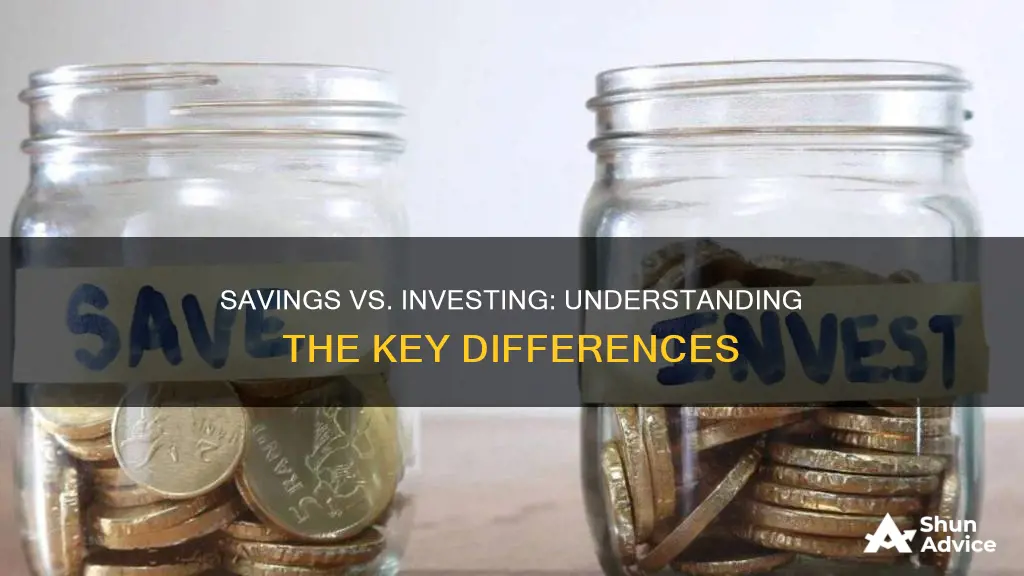
Saving and investing are both important concepts for building a sound financial foundation, but they are not the same thing. While both can help you achieve a more comfortable financial future, it's crucial to understand the differences between the two and when it's best to save or invest. This paragraph will explore the key distinctions between saving and investing, providing insight into their unique roles in personal finance and offering guidance on when to choose one over the other.
| Characteristics | Values |
|---|---|
| Risk | Savings: Minimal risk of losing money |
| Investing: Higher risk of losing money | |
| Returns | Savings: Predictable, stable returns |
| Investing: Fluctuating returns, potential for high returns | |
| Access | Savings: Immediate access |
| Investing: Barriers to access, e.g. penalties or taxes | |
| Time horizon | Savings: Good for short-term needs and goals |
| Investing: Good for long-term goals | |
| Financial goals | Savings: Emergency fund, short-term purchases, down payments |
| Investing: Retirement, college funds, building generational wealth | |
| Account types | Savings: Savings accounts, money market accounts, CDs, government bonds |
| Investing: Brokerage accounts, retirement accounts, education savings plans |
What You'll Learn

Saving for the short term vs investing for the long term
Saving for the short term and investing for the long term are two different strategies for achieving financial goals. Here are the key differences between the two:
Saving for the Short Term
Short-term savings are ideal for financial goals that you want to achieve in the next three to five years. This includes building an emergency fund, saving for a down payment on a house or car, or funding upcoming travel plans. Short-term savings are typically stored in low-risk accounts such as savings accounts, money market accounts, or certificates of deposit (CDs). These accounts offer easy access to your money and provide a safe place to store your funds with minimal risk of loss. However, the trade-off is that they earn lower returns compared to long-term investments.
Investing for the Long Term
Long-term investing is suitable for financial goals that are at least three to five years away. This includes retirement planning, building generational wealth, or funding education expenses. Investing typically involves purchasing assets such as stocks, bonds, mutual funds, or exchange-traded funds (ETFs). These investments have the potential for higher returns but come with a higher risk of losing money. It's important to note that investing is generally done for the long term, as it allows your investments to recover from any short-term losses and fluctuate with the market.
Key Differences
- Risk: Short-term savings have minimal risk, while long-term investing carries a higher risk of losing money.
- Returns: Short-term savings offer predictable and stable returns, while long-term investing offers the potential for higher returns but with fluctuations.
- Access: Short-term savings provide immediate access to your funds, while long-term investments may have penalties or taxes for early withdrawal.
- Goals: Short-term savings are ideal for immediate or near-term expenses, while long-term investing is suitable for financial goals that can be achieved over several years.
In conclusion, both short-term saving and long-term investing play important roles in financial planning. Short-term savings provide a safe and accessible place for your money, while long-term investing offers the potential for higher returns over time. It's essential to consider your financial goals, time horizon, and risk tolerance when deciding between saving and investing.
Capital Deployment: Understanding Loan and Investment Usage
You may want to see also

The risks of saving vs investing
The Risks of Saving vs. Investing
Saving and investing are both important for building a sound financial future, but they come with different levels of risk. Saving typically results in lower returns but with almost no risk, while investing offers the opportunity for higher returns, but you take on the risk of losing money. Understanding the risks of each can help you make informed decisions about when to save and when to invest.
Risks of Saving
While saving is generally considered a low-risk activity, there are still some potential drawbacks to consider:
- Low returns: Savings accounts typically offer low interest rates, which may not keep up with inflation. As a result, you may lose purchasing power over time, as the value of your savings decreases relative to the cost of goods and services.
- Opportunity cost: By keeping your money in a savings account, you may miss out on the potential for higher returns from riskier investments. This is known as an opportunity cost, as you are foregoing the potential gains of investing in favour of the security of saving.
- Fees and minimum balance requirements: Some savings accounts may charge monthly maintenance fees or require a minimum balance to waive these fees. If the monthly fee is higher than the interest earned, you could end up losing money.
- Limited growth: Savings accounts are best suited for short-term financial goals, as the low returns may not help you achieve long-term goals like retirement or college funding.
Risks of Investing
Investing, on the other hand, comes with a higher level of risk but also the potential for higher returns:
- Risk of loss: When you invest, there is always the possibility of losing some or all of your investment. The value of investments can fluctuate due to various factors, and there are no guarantees that you will make money.
- Volatility: The financial markets are constantly changing, and investment values can go up or down. This volatility can be challenging to navigate, especially for those with a low risk tolerance.
- Tax implications: Selling investments that have gained value may trigger capital gains taxes. Additionally, investment earnings may be subject to ordinary income taxes, reducing your overall returns.
- Fees and minimums: Investment accounts often come with various fees, such as trading fees, account fees, and management fees. There may also be minimum balance requirements or investment minimums that you need to consider.
- Time horizon: Investing is typically recommended for long-term goals, as it allows time to ride out short-term downturns in the market. If you need the money within a few years, investing may not be the best option.
In conclusion, both saving and investing come with their own set of risks. Saving is generally considered safer, but it may not provide the returns needed to achieve long-term financial goals. Investing, on the other hand, offers the potential for higher returns but comes with the risk of losing money. It's important to carefully consider your financial goals, time horizon, and risk tolerance before deciding whether to save or invest.
Seeking Investors for Your Farm?
You may want to see also

Liquidity of savings vs investments
Liquidity is a key consideration when distinguishing between savings and investments. It refers to how quickly and easily an asset can be converted into cash without losing value. Generally, savings are considered more liquid than investments, but there are exceptions.
Savings accounts are designed to be highly liquid, allowing easy access to funds for day-to-day spending and emergencies. Checking accounts are the most liquid type of savings account, as they do not limit withdrawals. Savings accounts also fall into this category, but federal regulations, such as Regulation D in the US, limit the number of certain transactions per statement cycle, typically to six. Money market accounts are another type of highly liquid savings vehicle, offering check-writing and debit card privileges. However, they may have minimum balance requirements and withdrawal restrictions, and their liquidity can be reduced by these factors.
Investments vary in terms of liquidity. Some investments, like stocks, bonds, mutual funds, and exchange-traded funds (ETFs), are considered liquid assets as they can be quickly converted to cash, usually within a few days. On the other hand, investments like real estate, art, and jewellery are considered illiquid as they can take a long time to sell and may be sold for less than their true value.
It's important to note that there is a trade-off between liquidity and yield. While liquid assets provide easy access to funds, they often have lower interest rates or returns. Less liquid investments, such as certificates of deposit (CDs) or long-term investments, typically offer higher yields but come with early withdrawal penalties or restrictions on accessing funds.
When deciding between savings and investments, it's crucial to consider your financial goals and risk tolerance. Savings accounts are ideal for short-term goals and emergency funds, while investments are better suited for long-term goals, such as retirement, where you can sacrifice liquidity for higher returns. Diversification is also key—spreading your funds across a range of liquid and illiquid assets can help you achieve both short- and long-term financial goals.
Tesla: The Future of Electric Cars
You may want to see also

Returns on savings vs investments
Returns on savings are generally low, with savings products offering low interest rates. However, savings accounts are a good option if you need to access your money in the near future and can't afford to lose any of it. Savings accounts are also a great way to meet short-term financial goals and prepare for unexpected situations. They are also a good way to build an emergency fund.
On the other hand, investing has the potential for higher returns than savings accounts. Investing in stocks, for example, can provide much higher returns than savings accounts. However, investing always comes with the risk of losing money and there is no guarantee that you will make money. It is important to do your research and understand the potential risks associated with different types of investments. Additionally, investing requires discipline and a long-term perspective.
When deciding between saving and investing, it is important to consider your financial situation, goals, and risk tolerance. If you need money in the short term, saving is usually a better option as it provides more liquidity and lower risk. If you are saving for retirement or other long-term goals, investing may be a better option as it offers the potential for higher returns.
It is worth noting that both saving and investing are important components of a healthy financial plan. A well-rounded approach that includes both can help build wealth, protect against financial shocks, and provide a solid foundation for a secure financial future.
Retirement Planning for Dentists: Securing Your Golden Years
You may want to see also

Tax on savings vs investments
Savings and investments are both important for building a sound financial foundation, but they are not the same thing. Savings typically result in lower returns but with virtually no risk. In contrast, investing allows for higher returns but comes with the risk of loss.
In terms of taxation, the treatment of savings and investments differs. Here are some key points on tax on savings vs investments:
Tax on Savings:
- Savings interest is usually paid gross, meaning tax isn't deducted upfront.
- Most individuals are allowed a certain amount of tax-free interest every tax year.
- Interest is counted in the tax year you can access it, which may differ from the year it was earned.
- Joint account interest is typically split equally for tax purposes.
- If your earnings exceed your allowance, the tax code may be adjusted, resulting in automatic tax payment.
- The tax on savings interest is typically charged at the standard income tax rate.
- Examples of taxable savings interest include bank accounts, credit union accounts, investment trusts, government bonds, and some life insurance contracts.
- Cash ISAs are a tax-free savings option, with limits on how much can be saved annually.
Tax on Investments:
- Investment income is generally taxed at the standard income tax rate and counts towards your Personal Allowance.
- There is a separate tax-free allowance for dividends, which are portions of a company's profits paid to shareholders. For the 2024/25 tax year, the tax-free threshold for dividends is £500.
- Dividend tax rates vary based on income tax bands.
- Stocks and shares ISAs are a tax-efficient way to invest, offering tax-free dividend income within specified annual limits.
- Profits and gains from cryptoassets are typically subject to capital gains tax.
In summary, while both savings and investments are crucial for financial planning, they are taxed differently. Savings interest is typically taxed at the standard income tax rate, while investment income may include dividend income taxed at varying rates depending on income levels. Additionally, tax-efficient options like cash ISAs and stocks and shares ISAs can provide tax-free returns within certain limits.
Euro: A Smart Investment Move?
You may want to see also
Frequently asked questions
Savings are usually put into the safest places or products that allow you access to your money at any time. Examples include savings accounts, checking accounts, and certificates of deposit. Your deposits may be insured by the Federal Deposit Insurance Corporation (FDIC). When you invest, you have a greater chance of losing your money than when you save. You could lose your "principal," which is the amount you've invested. But when you invest, you also have the opportunity to earn more money than when you save.
Saving money is best when you have immediate or near-term expenses that your monthly income wouldn't cover. It can take time to build up savings for dedicated expenses, but doing so means you avoid taking on high-interest debt because there's a guaranteed pot of cash to pull from.
For financial goals that are at least three to five years away, the benefits of investing generally outweigh the risks. For example, if you're planning for retirement or building wealth to pass down to your kids.
A good rule of thumb is to save enough to cover three to six months' worth of living expenses in an emergency fund. A savings account is a great way to meet short-term financial goals and prepare for unexpected situations. While investing is a way to reach long-term financial goals, such as saving for college or retirement.







